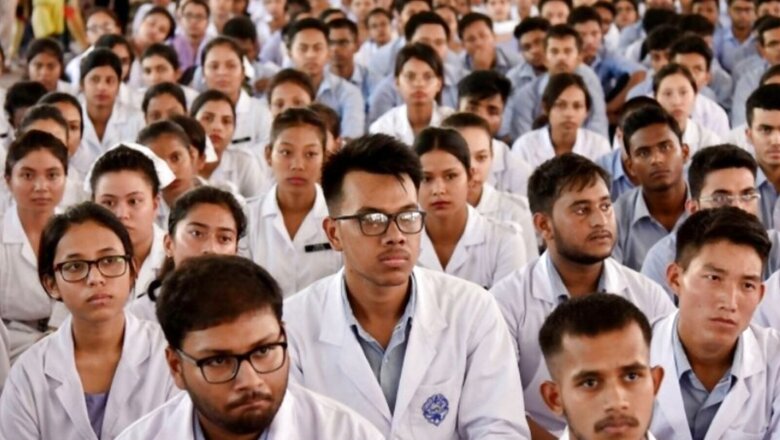
views
In the past two weeks, the carping critics have labelled the returning medical students from Ukraine as “unlucky”, “useless” or even “worthless”. When translated into Hindi, “bechare” “nikamme” and “nalayak” sound gross.
Everyone seems to have their own opinion on the credentials of these students apart from a sorry feeling for what they had to go through in war-ravaged Ukraine.
On March 17, justice Rekha Palli of the Delhi High Court said that she “cannot lose sight of the fact that on account of the lack of adequate number of medical institutions providing quality affordable education to cater to the needs of the aspiring students, they are often compelled to leave behind their home country and pursue their studies abroad”.
The high court’s observation came while granting permission to increase seats in post-graduate and undergraduate courses in Santosh Medical College.
Justice Palli’s observations hit the bull’s eye. The government’s inability to provide enough seats for MBBS, despite a woeful shortage of doctors in India, cannot be neglected.
India has around 90,000 seats for MBBS seats whereas around 16 lakh students appear for its entrance test across India.
At least 47,000 seats are in government colleges, where fees are nominal ranging between Rs 50,000 to Rs 80,000 annually, whereas in 42,000 private colleges fees, the fees average at Rs 16 lakh to 20 lakh annually.
Usually, students who go abroad to earn an MBBS degree are those who either fail to get a seat in Indian colleges due to poor rank or fail to get “reasonably priced” seats.
It shows the demand for MBBS seats, which translates into the aspiration to become doctor, is high, whereas the supply of seats – opportunities to become a doctor – is handful.
However, in reality, India also needs those aspirants to become doctors, urgently. A study found that in India, there were only 4.8 practicing doctors per 10,000 people in 2014, in contrast to the belief of having seven doctors per 10,000 people. It concluded that it looks like an impossible task to achieve even a moderate doctor-population ratio of 1:1,000 by 2030.
In the previous Health Matters, which appeared on March 7, I responded to Union Minister Prahlad Joshi’s comment on questioning the credibility of foreign-returned doctors based on the trend of high failure rate in the screening test. I had mentioned that while the minister’s statement obfuscates the main issue, it definitely needs rational scrutiny.
In this episode, I come back with an attempt to offer the solution to fix the shortage of medical seats and hence doctors in India.
The five suggestions have been compiled after speaking to more than a dozen officers which includes health experts, former officers at the government’s apex bodies, including the erstwhile Medical Council of India, deans of medical colleges and reputable doctors.
A MEDICAL COLLEGE IN EACH DISTRICT HOSPITAL
All district hospitals can be attached with a medical college. It can solve several issues in one go, such as the addition of more seats for medical students and shortage of doctors in rural areas.
State governments can be supported financially to strengthen the district hospitals for opening medical colleges. Ideated by public health specialist, Dr K Srinath Reddy, the specialists in the district hospitals can be deployed as faculty for the new medical colleges.
Not just medical colleges, he believes that nursing colleges can also be opened alongside the district hospitals to generate a multi-skilled health workforce.
Furthermore, seats can be reserved for medical students coming from the same or neighbouring districts. These students can be asked to sign a contract for some years, say 10, during which they cannot choose to migrate out to urban areas for job postings, hence, reducing the shortage of doctors in rural/remote areas.
While a similar model, but under public-private partnership (PPP), has been adopted by the Uttar Pradesh government, it can have several repercussions, as healthcare services will shift more in the private hands.
In UP, the plan is to handover the district hospitals to the private sector to open medical colleges.
The PPP model has to be dealt with extreme caution. Ideally, the operational control of public hospitals should rest with the state government, while the private player should only intercede to augment facilities, add capital and in return can use the clinical facility for training of their undergraduate candidates.
ALLOW TOP PRIVATE HOSPITALS TO ATTACH MEDICAL COLLEGES
“What makes you ask for a fee of Rs 80 lakh to Rs 1 crore for MBBS,” I asked two officials working at private medical colleges.
The answer was common – the investment is huge, specifically, the cost of land on which the college is built.
“It takes around Rs 300 crore to Rs 400 crore to build a medical college and a big chunk of investment goes into buying land, besides equipping hospitals to the level of tertiary care,” Girdhar Giani, general secretary of the Association of Healthcare Providers of India (AHPI) said. The lobby group AHPI represents 2,500 super-specialty and 8,000 smaller hospitals across India, including Fortis, Apollo, Medanta and Max Healthcare.
As per the rules, you can only build a medical college if you have land equal to or above 25 acres (more than one lakh square feet).
To give you a rough idea, New Delhi’s premier ITC’s Maurya Sheraton, which is known for hosting top guests including Donald Trump, George W Bush, Bill Clinton, Barack Obama and Jimmy Carter, is built on 5.5 acres.
If the government removes the compulsion of 25 acres, several top private hospitals such as Fortis, Apollo, Medanta among others can be allowed to open medical colleges. These hospitals have top-class doctors who can become faculty as well.
“If not 100-bedded, then all 300 or more bedded hospitals can be allowed to open medical colleges with a minimum of 50 MBBS seats. These hospitals can further invest in reasonable pieces of land, if the requirement of 25 acres is modified, within or near their hospitals.”
According to the present rule, to open a 100-seated medical college, one needs to have a hospital with a minimum of 430 beds.
A top doctor, who is a member at several government panels, shared an example of how Cuba runs medical colleges, explaining that the rule of asking for a huge plot of land is meaningless. “Ultimately, students have to bear the cost.”
“In Cuba, you will find classes of medical colleges going on or the labs constructed in an official complex or a shopping complex. Like any other office, they open classes and train students.”
According to the World Bank Data, Cuba has one of the highest number of doctors per 1,000 people. The WHO recommends 1 doctor for every 1,000 patients, whereas Cuba has 8.42 doctors for every 1,000 patients.
RUN EXISTING COLLEGES IN DOUBLE SHIFTS
Estimates show that two-thirds of India house one-third of medical colleges.
“Increasing the batch size is not a good idea,” a dean of a government medical college said, saying that it impacts the quality of learning.
But running colleges in double shifts may exhaust the faculty – the idea may need fine-tuning but it does not require any capital expenditure, only a slight spike in variable expenditure such as electricity bills, salaries etc.
According to Bipin Batra, former director of National Board of Examination (NBE) – a top body responsible for conducting medical entrance tests in India – a hybrid learning model should be adopted going forward.
“Faculty can be incentivised, intelligent rosters can be designed and common classrooms can be created by virtually linking multiple medical colleges to share professors for subjects, where there is a shortage of faculty, along with using smart learning methods such as pre-recorded lectures.”
The operational expenses required can simply be adjusted against the fee of additional candidates enrolled.
INCENTIVISE PHILANTHROPY, MINORITY INSTITUTIONS TO INVEST
Separate policies to incentivise corporate social responsibility (CSR), philanthropy and faith-based institutions should be brought in to invest in medical institutions.
These categories can invest a good amount of funds, if tax incentives and policy benefits such as land concessions, single window clearance for setting up medical colleges and hospitals could be brought in.
Also, minority-run institutions have excelled in providing top-notch doctors to India. Top medical colleges such as Maulana Azad Medical College in New Delhi, Christian Medical College in Vellore, St. John’s Medical College in Bengaluru have excelled in giving high-quality doctors.
A separate policy could be made to encourage minority-run trusts.
RELEASE LIST OF TRUSTED FOREIGN COLLEGES
The idea may not lead to addition of seats for medical students who want to study in India. However, it can help parents and students make an informed choice when planning to go abroad.
“I am told that there are certain colleges in foreign countries where a batch of students consists of even 900 students. Parents send their children without knowing these facts,” Dr K Srinath Reddy revealed in an elaborate discussion on the subject.
Instead of treating foreign-returned students with mockery, the central government can rank and release the country-wise list of medical colleges based on the performance of their students in India’s screening exam – Foreign Medical Graduate Exam (FMGE).
It can be a document similar to the list of UGC-recognised universities that Indian parents and students refer to before applying for admission.
Moreover, experts believe that there are several medical colleges across the globe, for whom Indian students constitute a main clientele, who will be ready to amend their curriculum based on the suggestions from India.
Batra from NBE said that the institutions in Mauritius, Nepal and Philippines have adopted Indian curriculum for undergraduate programmes and the results are visible in the high number of candidates qualifying the screening tests.
This move will help improve the pass percentage of FMGE (the current pass percentage is as low as 15%) and will add around 20,000 trained MBBS doctors to India per year, without any load on the exchequer.
Read all the Latest News India and Breaking News here

















Comments
0 comment